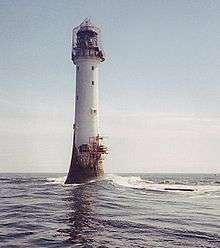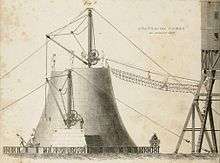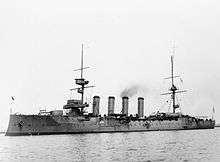Bell Rock Lighthouse
The Bell Rock Lighthouse, off the coast of Angus, Scotland, is the world's oldest surviving sea-washed lighthouse.[4] It was built between 1807 and 1810 by Robert Stevenson on the Bell Rock (also known as Inchcape) in the North Sea, 11 miles (18 km) east of the Firth of Tay. Standing 35 metres (115 ft) tall, its light is visible from 35 statute miles (56 km) inland.[1]
 Bell Rock Lighthouse with reef just visible | |
 Scotland | |

| |
| Location | Inchcape Arbroath Scotland |
|---|---|
| Coordinates | 56.4342°N 2.3873°W |
| Year first constructed | 1810 |
| Year first lit | 1 February 1811[1] |
| Automated | 1988 |
| Foundation | Aberdeen granite |
| Construction | Aberdeen granite tower |
| Tower shape | tapered cylindrical tower with balcony and lantern including keeper's quarter |
| Markings / pattern | white tower with brown band at the base, black lantern |
| Tower height | 35.3 metres (116 ft) |
| Focal height | 28 m (92 ft) |
| Intensity | 1900000 candela |
| Range | 18 nautical miles (33 km; 21 mi) |
| Characteristic | Fl W 5s. |
| Racon | M |
| Admiralty number | A3108 |
| NGA number | 2616 |
| ARLHS number | SCO-020 |
| Managing agent | Northern Lighthouse Board[2] [3] |
| Heritage | category A listed building |
The masonry work on which the lighthouse rests was constructed to such a high standard that it has not been replaced or adapted in 200 years.[5] The lamps and reflectors were replaced in 1843 and used in the lighthouse at Cape Bonavista, Newfoundland, where they are currently on display.[6] The working of the lighthouse has been automated since 1988.[1]
The lighthouse operated in tandem with a shore station, the Bell Rock Signal Tower, built in 1813 at the mouth of Arbroath harbour. Today this building houses the Signal Tower Museum, a visitor centre detailing the history of the lighthouse.
The challenges faced in the building of the lighthouse have led to it being described as one of the Seven Wonders of the Industrial World.[7]
History
According to legend, the rock is called Bell Rock because of a 14th-century attempt by the Abbot of Arbroath to install a warning bell on it. The bell lasted only one year before it was stolen by a Dutch pirate. This story is immortalised in "The Inchcape Rock", a poem by 19th-century poet Robert Southey. The rock was the scene of many shipwrecks as it lies just below the surface of the sea for all but a few hours at low tide.
By the turn of the 18th-cum-19th century, it was estimated that the rocks were responsible for the wrecking of up to six ships every winter. In one storm alone, seventy ships were lost off the east coast of Scotland. The Scottish engineer Robert Stevenson had proposed the construction of a lighthouse on Bell Rock in 1799, but cost concerns and the relatively radical nature of the proposal by a young engineer caused it to be shelved. The loss of the warship HMS York and all on board in 1804 resulted in a furore in Parliament. Stevenson sent his design to John Rennie who approved the design and costing. Rennie's reputation led to legislation being passed in 1806 enabling construction to begin.[8]
The Northern Lighthouse Board awarded the contract to design and build to John Rennie, with Stevenson being appointed as chief assistant.[9] The design was based on the earlier Eddystone Lighthouse designed by John Smeaton, which Stevenson had inspected in 1801,[10] and which was also built on an offshore reef using interlocking stones.[11] It also contained newer features, such as rotating lights alternating between red and white designed by the carpenter Francis Watt.[12] Stevenson was totally responsible for construction and his written account of the work gave little or no credit to Rennie. "The apportionment of responsibility for this work led to prolonged disputes between their respective descendants, but it is now certain that while Stevenson designed the lighthouse in the main, Rennie's role too was significant."[13]
Construction

In 1807 Stevenson hired 60 men, including a blacksmith so that the pick axes used to cut the foundations could be re-sharpened on site. Stevenson did not want to use black powder as it might have damaged the rock on which the lighthouse was to stand. They set sail on 17 August 1807, to be away for two months.[14] While initially there was some reluctance about working on the Sabbath, in order to complete the lighthouse in time and on budget, the majority of the workers were prepared to work on Sundays, apart from four of the stonemasons who declined, but who later also worked on Sundays.[15]
For 20 hours each day, while the rock was covered by up to 12 feet (3.7 m) of water, the men lived on a ship moored 1 mile (2 km) off the rock. The first task was to build a beacon house on tall wooden struts, so the men would have a place to stay on the reef, instead of the time-consuming row to and from the ship each day and after an incident whereby one of the boats came adrift. The beacon house had places for 15 men. The foundations and beacon legs were raised during the first season. During the winter, work on the lighthouse was paused as stonemasons cut rocks for the lighthouse out of Aberdeen granite.[14]
During early 1808, work resumed. The beacon house barracks was completed and the first three courses of stone were laid. In the whole of the second season only 80 hours of building work took place on the rock. During this time, before the completion of the barracks, a young worker was knocked unconscious by a buoy ring and drowned. As he was the primary breadwinner for his family, Stevenson offered the now-vacant position to his younger brother Alexander Scott, who accepted.

In September 1808 John Bonnyman, a stonemason, had to have a finger amputated following an accident with the beam crane on the Rock; as recompense for this mishap he was later appointed one of the first lighthouse keepers.[17]
Stevenson was frustrated by a visit from Rennie, in 1809, whom he saw as interfering with his work. As a strategy to ward off further visits, he wrote Rennie a total of 82 letters, asking detailed questions about a large range of construction issues (including what type of window putty and locks to use). Rennie replied in detail to every letter, but Stevenson largely ignored the replies.
In June 1809 one of the principal builders, Michael Wishart, was caught beneath a crane when it collapsed, and his feet were severely injured, preventing him from working further on the project.[18] He asked Stevenson if he could be appointed lighthouse keeper and he ultimately took up a position as assistant keeper in 1811.[19]
Work stopped on 22 August 1809, by which time a large part of the tower had been completed.[14]
In January 1810, Stevenson's twins died of whooping cough, and a fortnight later his youngest daughter Janet also died of this disease. Rennie wrote Stevenson a consoling letter. During this final period of construction the lighthouse became something of a tourist attraction. Many people were anxious to see the completion of the tallest off-shore lighthouse in the world. In this final season, while the men were staying in the beacon house, a 7-hour storm struck. Worker Charles Henderson was lost, and his body was never found. Work was finally completed after having consumed about 2500 granite stones, all carried by one horse, Bassey.[14]
Ultimately, the project came in 50 per cent above the original estimate of £42,000 (2009: £2,490,000) budget.[20] Since the construction of the lighthouse the only recorded shipwrecks have been that of HMS Argyll during wartime blackouts in 1915 and the Banff-registered cargo vessel Rosecraig that ran aground in fog on the evening of 21 September 1908, and sank. Her seven crew members were saved.[21]
Loss of HMS Argyll

The lighthouse on the rock had been ordered to switch its lights off during the First World War for fear of assisting German U-boats in their operations, and the light was only turned on by special permission. On 28 October 1915 while in view of the lighthouse, HMS Argyll under the command of Captain James Tancred sent a signal requesting the light to be turned on. The ship proceeded on its course believing the signal had been received, but it had not and the light was not switched on. Soon afterwards, Argyll ran aground, suffering extensive damage to much of the hull. Two destroyers – HMS Hornet and HMS Jackal – assisted in the rescue of her crew. Despite the damage, there were no fatalities among her crew. After all valuable items onboard had been salvaged, including her 6-inch (150 mm) guns, she was blown up by the naval salvage team. In 1970, her two large propellers were recovered by divers and sold for scrap.
1955 helicopter accident
On 15 December 1955, RAF Bristol Sycamore helicopter XG501, crewed by Flight Sergeant P. A. Beart and Sergeant E. F. Hall, departed from RAF Leuchars at 09:35 to perform a sea-winching exercise at the Bell Rock lighthouse. At approximately 10:00, the helicopter's tail rotor struck the anemometer on the top of the lighthouse, and as a result the aircraft crashed into the sea. The incident was witnessed by the crew of a second helicopter that immediately transmitted a distress call and flew to the scene of the crash. In response to the distress signal, four aircraft, a further two Sycamore helicopters, an RAF rescue launch and three lifeboats searched the area, recovering the body of XG501's navigator; the body of the pilot was not recovered. The lighthouse was damaged, including the loss of its light, but its keepers were uninjured. Owing to bad weather, the lighthouse could not be repaired until after 20 December, when conditions permitted the delivery of supplies.[1][22]
In music and literature
Scottish musician Alastair McDonald re-worded a traditional song called The Mermaid's Tale, and set the scene on Bell Rock instead of the Eddystone light. The first verse runs:
- My father was the keeper of the Bell Rock Light
- And he married a mermaid one dark night
- And from this union there came three
- A codling and a kipper and the other was me
Arbroath musician Ian Lamb also slightly reworked the melody for the traditional song "Come All Ye Tramps and Hawkers" and wrote "The Bell Rock Light" to mark the lighthouse's bicentenary in 2011. The first verse runs:
- We left the town of old Arbroath and set out on the sea
- The wind blew from the east that day it proved cold company
- The Inchcape Reef was our plain aim where many lives were lost
- Countless ships had hit the rock at dreadful human cost
R. M. Ballantyne's novel The Lighthouse (1865) is centred on the construction of the Bell Rock Lighthouse.
See also
- Cranhill, area of Glasgow with streets named after lighthouses, including Bell Rock
- List of Northern Lighthouse Board lighthouses
- Trinity House of Leith
References
- "Bell Rock Lighthouse", Northern Lighthouse Board, archived from the original on 14 April 2012, retrieved 20 October 2009
- Bell Rock The Lighthouse Directory. University of North Carolina at Chapel Hill. Retrieved 9 May 2016
- "Northern Lighthouse Board - Bell Rock". Northern Lighthouse Board. Retrieved 20 January 2019.
- "Bell Rock Lighthouse", David Taylor, retrieved 20 October 2009
- Coast Revisted 19 August 2007 – BBC 2
- "Cape Bonavista lighthouse", Foghorn Publishing, retrieved 2 September 2012
- Cadbury (2003), pp. 65–106
- Cadbury, Deborah (2003), Seven Wonders of the Industrial World, Fourth Estate, pp. 76–77CS1 maint: ref=harv (link)
- Harman, Claire (2005), Robert Louis Stevenson, Harper Collins, p. 7
- Harman (2005), p. 6
- "Both engineers agree in describing the lighthouse as being a copy of Smeaton's Eddystone Tower with sundry improvements in details and dimensions." Boucher, Cyril Thomas Goodman (1963), John Rennie, 1761–1821: The Life and Work of a Great Engineer, p. 59
- Boucher (1963), p. 61
- Saint, Andrew, "Rennie, John (1761–1821)", Oxford Dictionary of National Biography (online ed.) (subscription or UK public library membership required)
- Seven Wonders of the Industrial World, BBC TV
- Stevenson, Robert Louis (2011), Records of a Family of Engineers, Cambridge University Press, ISBN 9781108026611
- "Bell Rock Lighthouse". National Galleries: Collection. National Galleries of Scotland. Retrieved 18 January 2016.
- "Operations of 1808", Bellrock.org.uk
- Stevenson, Robert, The Bell Rock Lighthouse, Cambridge University Press, p. 82
- "1811–1823". Bellrock.org.uk.
- Lynn F. Pearson Lighthouses Volume 312 of Shire book, Osprey Publishing, 2003 ISBN 0-7478-0556-3
- Banffshire Journal archives
- "Helicopter Crash, Bell Rock Lighthouse", UK Parliament, 12 December 1955
Further reading
- Bathurst, Bella, The Lighthouse Stevensons, Harper Perennial, ISBN 0-00-720443-4
- Seven Wonders of the Industrial World, BBC TV Series and DVD
- Cadbury, Deborah, Seven Wonders of the Industrial World, Fourth Estate, ISBN 0-00-716304-5
- Cadbury, Deborah, Dreams of Iron and Steel, Fourth Estate, ISBN 0-00-716306-1
- The Miracle Lighthouse, National Geographic Channel Documentary, October, 2007, BBC Production, 2003
External links
| Wikimedia Commons has media related to Bell Rock Lighthouse. |
- Northern Lighthouse Board
- A Reference Site for Stevenson's Bell Rock Lighthouse
- Northern Lighthouse Board history of the light
- Biographical Sketch of the Late Robert Stevenson: Civil Engineer by his son Alan Stevenson, Read at the Royal Society of Edinburgh, at the meeting of 17 February 1851, and dealing at length with the Bell Rock Lighthouse. From Google Book Search
- Christopher Spencer, Who Built the Bell Rock Lighthouse?, BBC, British history, Empire and Sea Power, 2003.
- The Building of the Bell Rock from Records of a Family of Engineers by Robert Louis Stevenson